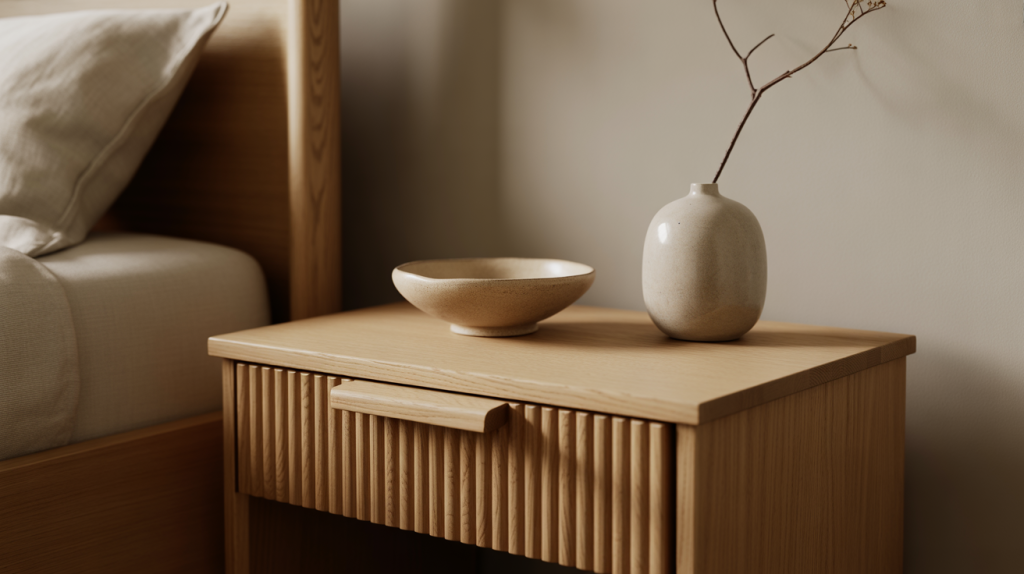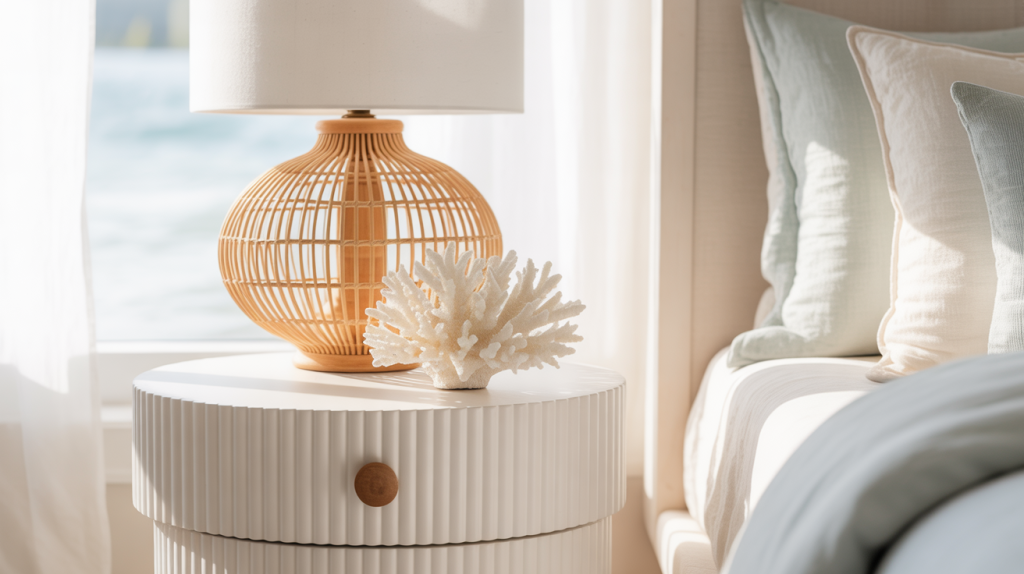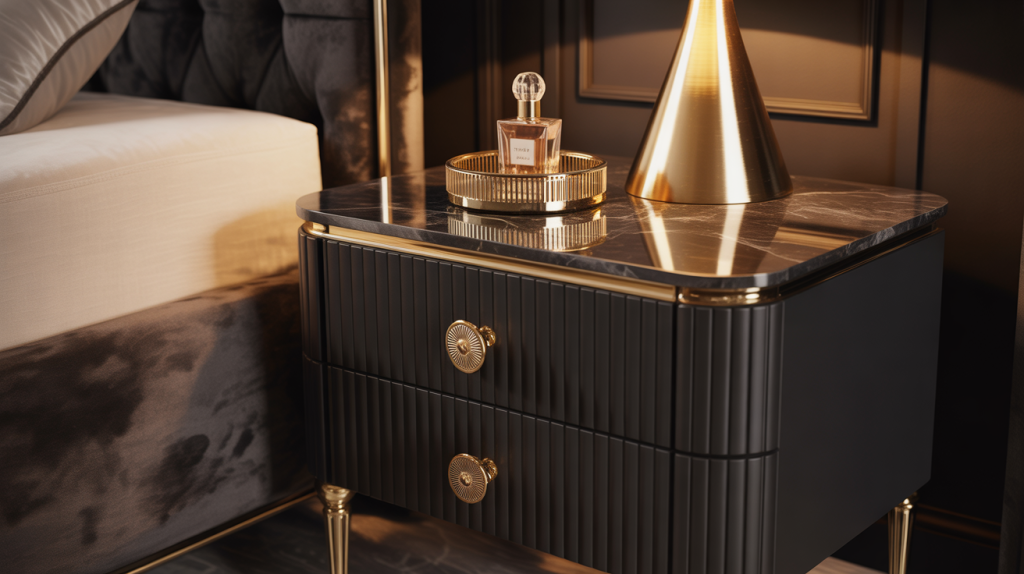
At FZA Home, we believe that exceptional design lies in the details. It’s the subtle textures, the clean lines, and the intentional choices that elevate a room from merely functional to truly inspiring. In recent years, no single detail has captured the imagination of the design world quite like fluting—the elegant, rhythmic series of vertical grooves that adds depth, character, and a touch of architectural grace to furniture.
The fluted nightstand, in particular, has emerged as a must-have statement piece. It’s a masterful blend of classic inspiration and contemporary flair. However, its bold personality and rich texture can also present a styling challenge. How do you adorn a surface that is already a work of art without creating visual clutter? How do you ensure it harmonizes with your overall bedroom aesthetic?
A fluted nightstand is a standout piece with strong character. The key is balancing its bold texture with the right decor. In this comprehensive guide, our design team at FZA Home will share the exact formulas we use for our catalog photoshoots to integrate these stunning nightstands into five completely different modern aesthetics, ensuring a harmonious and designer-approved look.
The Allure of Texture: Why Fluted Nightstands Are a Design Staple
Before diving into the “how-to,” it’s important to understand the “why.” What makes fluting so compelling in modern interior design? Its appeal is rooted in a few key principles.
First, it introduces tactile and visual texture. In an era where design can sometimes lean towards the flat and overly simplistic, fluting brings a much-needed layer of sensory depth. The play of light and shadow across the grooved surface creates a dynamic effect that changes throughout the day, adding life and movement to the piece.
Second, it evokes a sense of timeless luxury. Fluting has its roots in classical Greek and Roman architecture—think of the majestic columns of ancient temples. This historical reference lends the design a feeling of permanence and sophistication. It’s a trend that feels grounded in history, not just a fleeting fad.
Finally, it’s incredibly versatile. While it makes a statement, the simple, repeating vertical lines allow it to blend seamlessly into numerous decor styles, from the warmly minimal to the richly glamorous, as we will explore.
The Foundation of Great Styling: Core Principles
Before we break down the five specific looks, our designers at FZA Home adhere to a few foundational principles when approaching any textured surface. Mastering these will give you the confidence to style your fluted nightstand like a professional.
- Principle 1: Balance the Texture. The fluted surface is visually “busy.” To create a calming vignette, the decorative objects placed on top should generally be simpler, with smooth surfaces and clean lines. Avoid items that are overly patterned or intricately detailed, as they will compete with the nightstand’s primary feature.
- Principle 2: Complement, Don’t Compete. Every item should feel like it belongs. The goal is to create a cohesive story where the decor enhances the nightstand, and the nightstand enhances the decor. Choose materials and colors that complement the nightstand’s finish, whether it’s the warm tones of natural wood or the crispness of a white lacquer.
- Principle 3: Mind the Scale and Proportions. The size of your decor matters immensely, especially on a surface that commands attention. A lamp that is too bulky or a stack of books that is too high can throw off the entire balance. This principle is crucial for any bedside table, a concept we explore further in our guide to styling small nightstands. Always ensure your chosen items are proportional to the nightstand’s surface area.
A Designer’s Playbook: 5 Styled Looks for a Fluted Nightstand
Here, our team breaks down how to achieve five distinct, modern aesthetics using a fluted nightstand as the anchor.
1. The Japandi Sanctuary
- The Vibe: Japandi is a hybrid of Japanese minimalism and Scandinavian warmth. It’s serene, functional, and deeply connected to nature. The focus is on natural materials, neutral colors, and uncluttered spaces.
- The Nightstand: A natural light oak or walnut fluted nightstand with simple, clean lines.
- The Styling Formula:
- Lighting: A simple, sculptural lamp with a ceramic base in a neutral tone (ivory, beige, or charcoal) and a textured linen or paper shade.
- Object: A single, imperfectly shaped stoneware or ceramic bowl (wabi-sabi style). It can be empty or hold a few small, smooth stones.
- Organic Element: One or two dried, structural stems—like a branch of pampas grass or a twisted willow branch—in a minimalist bud vase.
- Why It Works: This look is a masterclass in texture. The smooth ceramic, the rough linen, the dried botanicals, and the fluted wood all complement each other without competing. The color palette is restrained and earthy, creating a profoundly calming and organic feel. This style celebrates the inherent beauty of natural materials, a key feature of many modern wood nightstands.
2. The Dark Academia Study
- The Vibe: Moody, intellectual, and nostalgic, Dark Academia draws inspiration from classic literature, art history, and university life. It favors dark colors, rich textures, and objects with a sense of history.
- The Nightstand: A dark walnut or black fluted nightstand, preferably with a touch of brass or gold hardware.
- The Styling Formula:
- Lighting: A vintage-style “banker’s lamp” with a green glass shade or a classic pharmacy lamp in an aged brass finish to provide focused, warm light.
- Objects: A stack of two or three classic, cloth-bound hardcover books. On top, place a pair of vintage reading glasses or a single, elegant fountain pen.
- Personal Touch: A high-quality scented candle in a dark glass jar with a scent like sandalwood, leather, or cedar.
- Why It Works: The dark fluted wood provides the perfect moody backdrop. The brass hardware and warm lighting pop against the dark finish, creating a sophisticated contrast. Each item feels curated and intellectual, contributing to the narrative of a well-read, thoughtful individual.
3. The Coastal Retreat

- The Vibe: Light, airy, and relaxed, the modern coastal aesthetic is inspired by the seaside without being overly thematic. It’s about soft whites, natural textures, and a feeling of breezy openness.
- The Nightstand: A fluted nightstand painted in a soft white or a very light, bleached-wood finish.
- The Styling Formula:
- Lighting: A lamp with a base made of a natural material, like light-colored ceramic, woven rattan, or a clear glass base filled with small shells or sea glass. The shade should be a crisp white linen.
- Object: A beautiful piece of authentic coral, a large seashell, or a stack of books with spines in shades of blue, white, and sand.
- Container: A small, shallow woven tray to hold a lip balm, a sleep mask, or other small essentials, keeping the surface organized. The ample storage within a classic wooden nightstand with drawers is another way to maintain a clear and organized surface.
- Why It Works: This style leans into natural, textural elements. The fluting on the nightstand mimics the lines of shiplap or weathered fences. The combination of woven materials, natural objects, and a light color palette creates a serene, vacation-like atmosphere.
4. The Minimalist Haven
- The Vibe: Minimalism is about stripping away the non-essential to focus on form, light, and space. It is intentional, uncluttered, and highly functional. It’s not about emptiness, but about giving each object significance.
- The Nightstand: A crisp white or sleek black fluted nightstand, often with integrated, handle-less pulls to maintain a seamless profile.
- The Styling Formula:
- Lighting: A hyper-minimalist LED lamp with a thin, sculptural metal form, or no lamp at all if a wall sconce is used.
- Object: One single, high-design object. This could be a beautifully designed digital clock, a small, abstract metal sculpture, or a high-end wireless charging pad.
- Personal Item: A single, thoughtfully chosen book with a monochrome, graphic cover.
- Why It Works: In a minimalist setting, the fluted nightstand itself becomes the primary source of texture and interest. By keeping the surface almost bare, its architectural quality is highlighted. Every item is chosen for both its perfect function and its beautiful form.
5. The Modern Glam Sanctuary

- The Vibe: Sophisticated, luxurious, and a little dramatic. Modern glam is about mixing plush textures, metallic finishes, and high-contrast colors to create a chic, hotel-like environment.
- The Nightstand: A bold black or deep jewel-toned fluted nightstand, often accented with polished gold or brass hardware and a marble or stone top.
- The Styling Formula:
- Lighting: A lamp with a metallic base (polished gold or chrome) and a contrasting shade in a luxe material like black silk or velvet.
- Object: A small, mirrored or metallic tray. On the tray, place a designer perfume bottle and a small, lidded box for jewelry.
- Organic Element: A single, perfect flower—like an orchid or a deep red rose—in a small, elegant crystal or metallic vase.
- Why It Works: This look is all about layering luxe materials. The fluting provides deep texture, which is complemented by the smoothness of the metal, the sheen of the mirror, and the softness of the flower. The high contrast between the dark nightstand and the bright metallics creates a dynamic and opulent feel.
Beyond the Surface: Coordinating with Your Bedroom
A beautifully styled nightstand should not exist in isolation. To create a truly cohesive designer look, consider how it interacts with the rest of your room.
- The Headboard: With a textured nightstand, it’s often best to opt for a simpler headboard. A smooth, upholstered headboard in a solid color (like velvet or linen) provides a soft backdrop that allows the nightstand to stand out.
- The Bedding: Similar to the headboard, keep your bedding relatively simple. Solid-colored linens or those with a very subtle pattern will prevent a visual clash with the rhythmic lines of the fluting.
- The Rug: Choose a rug that complements the nightstand’s texture without mimicking it. A low-pile wool rug or a soft, solid-colored shag rug can provide a grounding foundation for the room.
Common Questions from the FZA Home Design Desk
Yes, absolutely. The strong vertical lines of a fluted design can actually help to draw the eye upward, creating an illusion of height and making a small room feel a bit taller. Opt for a lighter color like white or natural oak to maximize this effect.
Dust can settle in the grooves. The best method is to use a soft-bristled brush attachment on your vacuum cleaner to gently lift dust. For smudges, a slightly damp microfiber cloth wiped in the direction of the grooves works perfectly.
While it is certainly trending, our design team believes its classic, architectural roots give it significant staying power. Unlike loud patterns or niche colors, this texture is sophisticated and versatile, allowing it to adapt as your style evolves.
Final Thoughts
The fluted nightstand is a testament to the power of texture in design. It proves that a piece of furniture can be both a bold statement and a versatile foundation. By understanding its character and applying intentional styling choices, you can unlock its full potential and create a bedside vignette that is not only beautiful and organized but also a true reflection of your personal style.
Explore the curated collection of modern furniture at FZA Home to find the perfect piece to begin your styling journey.











